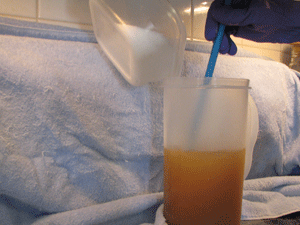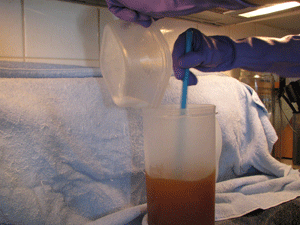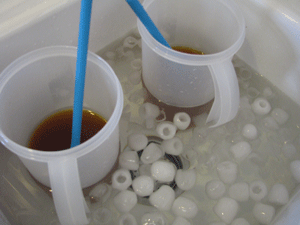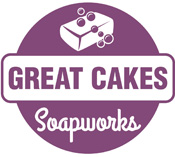How to Make Beer Soap
What is beer soap? Quite simply, it is soap that is made with beer as the liquid instead of water. However, let me say that if you have not made beer soap before, you should be fully prepared. It is not for the faint of heart because you will have to work quickly. You should have quite a few successful batches of cold-processed soap under your belt before attempting this process. In fact, I am not even providing a recipe, only a method. Ok, that’s my disclaimer. You can’t say I didn’t warn you!
After that disclaimer, now let me share WHY you might want to make beer soap. For me, it’s a great marketing hook. I often hear at the market – “Wow! Look at that! Beer soap!” Besides that, beer is also supposed to be a great conditioner for your skin.
Are you ready to get started now? First, you will need to prepare the beer and the oils a full day ahead. Using your regular soap recipe, start by pouring the beer (amount should be 40% of the oils – do NOT discount the liquid) into a plastic pitcher (do NOT use pyrex or glass) and letting it get flat. Really flat. If you have carbon dioxide bubbles, you will have lye bubbles which is really not safe. Once the beer is flat, I recommend boiling it to remove the alcohol, then cool it down in the refrigerator overnight.
The next day you can make soap. Here is my flat, non-alcoholic beer in the plastic pitcher just waiting for the lye to be added:

Now I add my lye EVER SO SLOWLY into the beer. Notice that I am wearing rubber gloves. Always wear your safety gear!!
It will turn a lighter yellowish color and start to stink pretty bad. That’s why I always make my lye solution under the fan under my microwave WHICH VENTS OUTSIDE. I also learned to cover the back of my stove with a towel. It seems that little bits of lye have eaten away some of the enamel finish. Oops. Back to the lye solution. If you pour the lye too quickly, the beer will heat up and cause a volcano. Ask me how I know! Fortunately, it was contained on my glass stovetop…

As the beer continues to heat up, it will turn back to a darker brown.

Once I have all the lye incorporated, I usually put the pitcher(s) in my sink with cold water and ice to speed up the cooling process. I’ve noticed that with a regular lye and water solution, the stink will eventually go away when all the lye has been fully incorporated. Not so much with the beer. In fact, the plastic pitcher will probably carry the smell even after you run it through the dishwasher too. So don’t think you can use it for lemonade when you’re finished making soap. NOT that you would use your lye pitcher for lemonade anyway!!

When the temperature of the lye solution reaches about 85-90 degrees, you’re ready to make soap. I usually use my stick blender for this soap, but you could also use a hand whisk. I just like the smoothness of soap that’s been blended with the electric blender. Not to mention the adrenaline rush of trying to get the soap made before it becomes a brick in your soap pot…

After about two seconds of stick blending, I add a little bit of wheat bran to this batch.

After stirring the wheat bran with my spoon, I add my essential oil blend. I like to stick blend this too just to be sure it’s all mixed in. Just for a few seconds though. Once it starts to thicken, it will set up fast.

Time to pour!

You can see that by the time I have it completely poured, it is really getting thick. I have a few seconds to smooth the top with my spoon, put plastic wrap over it, and cover it with a towel.

I usually cut this soap the next day. Sometimes I have to wait two. It requires a full 4-6 weeks to cure. And it really does NOT smell like beer when it’s all done. In fact, even by the time I cut it, all I can smell is the essential oil blend. Here’s my finished product:

Many thanks to my darling daughter (who will soon be eight) for taking pictures while I made this soap. I couldn’t have done it without her!
Page with Comments
Comments are closed.

Look at that! Those pictures are beautiful, and wow, beer soap.
Your daughter did a fantastic job too of taking pictures.
I always love looking at your soap pictures, they are quite amazing!
For some reason, I am getting a kick out of your ice cubes with the little holes in them, LOL
I remember as a kid when we would have ice like that, (not sure where it came from though), I would put them on my finger and think it was the greatest thing!
Have a great day!
.-= Maryann´s last blog post ..Lets get dirty, lets get raw! =-.
Thanks, Maryann! I thought she did a great job too!
We actually have an ice machine that we keep in the basement – hubby’s idea – since the icemaker in our fridge died. It makes those fun ice cubes. 🙂
WOW!! That looks so good – I will definitely be giving this a try, but thanks for the warnings, at least I know to be prepared and be careful! Do you mind me asking how big the batch was here?? It’s just that it looks a lot bigger than I’ve progressed to yet!
Thank u!! 🙂
Kriss
I made two batches – one after the other – each was about 80 ounces of oils. (That’s why you see two pitchers of lye solution in the sink.) Feel free to use your regular sized recipe!
Do you know if you can add flat beer to Melt and Pour Soap bases?
This was an excellent tutorial. I was wondering if I can substitute oatmeal instead of the wheat bran? Your daughter did an excellent job taking pictures. You should be really proud of her.
Sheila
Sheila – You can definitely substitute oatmeal! Just make sure it is the old-fashioned, regular oats – NOT the quick oats. I’ve ruined a batch of soap using the quick oats when I first got started! 🙂
Thank you so much for this!!! I am currently making my first batch of beer soap for a St. Patrick’s Day contest with some other soapers. I am soooo glad I listened and put it in a plastic pitcher. I was pouring slowly and all the sudden it did the volcano thing. Fortunately it stopped right at the top of the pitcher and settled back down again but my heart was racing and I was freaking out that I might have a chemical spill on my hands. The pitcher saved it. Phew!! I can’t wait to see how this turns out.
Whew! I’m so glad a disaster was averted! Congratulations on your first batch of beer soap! Hope you win the contest!
Ok, so I KNOW I’ve read this post before, but I’m finally getting around to making beer soap! Yay! I knew there was something special that I needed to do with the beer prior…glad I came back to read it. And holy cow Amy! That is the BIGGEST log mold I think I’ve ever seen! lol
YOur daughter did a perfect job with the pics! I will start my soap making (not with beer first, LOL) soon. I’ve gotten into meade and love it!
Why, thank you, Lady Darcien! You appear to be quite the seamstress as well – what a beautiful shop you have. Best wishes on the soapmaking – it truly is a fun thing to do!
Thanks for the great info! Do you happen to know if you can use any other alcoholic liquids in soaps?
@Cynthia – As a matter of fact, I have some friends who make wine soaps, but I’m pretty sure they boil the alcohol out. Unfortunately, the beautiful colors from the wine will not hold up to lye, but they do make interesting soaps!
It seem good! But beer is for drink!!!!
@Nadia – Ha ha! I don’t drink, so I like it in the soap! 🙂
I have a question regarding the 40% lye solution–so if I use 24 oz of beer, would I use 16 oz of lye? Is there a good website for figuring out the oils, water, lye ratio? I used an online calculator using the .38 ratio for water/lye to oils ratio and they recommended I use 16oz of lye (not discounted) but to use 46 oz of beer, not the 24oz I calculated using 40%. Are my ratios ok? Any help would be great ly appreciated!
@Nora – I didn’t say that correctly. I edited the information to say that the beer amount should be 40% of the oil amount. So if you use 24 oz. of beer and superfat at 5%, Soapcalc.com recommends 8.6 oz. of lye. Hopefully that is easier to understand now. Let me know if you have any further questions!
Thank you so much! The soap turned out very nice 🙂
@Nora – I’m so glad!!!
Very nice article, thank you. I am teaching my sister-in-law soap making today and thought “I wonder how beer would do in soap”, been a soapmaker for 15 yrs now and never thought of it before. But I think I will try it on my own first! The photos are just gorgeous!! I hope your daughter has kept up her photography. I am a photographer as well 🙂 http://www.redbubble.com/people/racheljayne
Thanks so much for the tips!
I want to make soap with honey mead. How much do I put in per pound of oils? Do I simmer it to cook out the alcohol. What about water? Does it replace the water?
cheryl
cherrychnagan@gmail.com
@cheryl – You will want to replace the water with the mead. And yes, you can simmer it to cook out the alcohol. This is the best method! Make sure you get it good and cold after the cook and be extra careful adding the lye. Best wishes!
I tried the beer soap last night – I used bud select 55 (because its all I had in the fridge and i dont drink that stuff anyway) I like dark beers but hadnt been to the store yet.
it came out nice – a pretty soap! and i didnt add any ess. oils or frag oils – just beer and crushed walnuts for the exfoliant… thanks for the recipe
@Mary Kay – I’m so glad you had such a successful batch! Thanks for letting me know. 🙂
Hello and thanks for the suggestions. I just started making soap a few weeks ago (I finally took the plunge when I was stuck inside my house during the big blizzard earlier this month). The beer soap is probably my 7th or 8th experience making HP soap in the crock pot. I used a dark ale which seemed to almost sieze rather than trace it thickened up so quickly. I honestly thought I was going to be tossing it out but decided to let it sit in the crock and my gosh it actually turned into a nice batch of soap! It has a very unique kind of caramel aroma. I added cedarwood, rosemary and tangerine EO for a slight aroma. Used it this morning and it lathers great!
@Jackie – Isn’t soapmaking just the best thing ever?? I can tell you’re already addicted – 7 or 8 batches in less than a month! Great job – and I’m glad it worked out so well. Sounds like a great EO blend too!
Can I make this soap with hot processing ?
@Renee – Apparently so! (see comment #26)
just came across this post as I did a search for beer soap recipes. I have been wanting to do a beer soap for awhile now and think I am going to try it now. Although I don’t think it will be ready for father’s day like I had hoped. thanks so much for the post; I just love reading your blog and you always have great info!
PS, can you tell me where you got your wooden mold? I would love to get one like that; thanks
@Jeanette – You would be cutting it pretty close to have it ready by Father’s Day, unless you hot process it. Oh, and my hubby made my mold for me!
You can use wine in soaps. I don’t cook the alcohol out. I do pour the lye very slowly into the wine. I have found that cutting the wine by half with water works much better than straight wine.
Put your lye pitcher into a larger cardboard box so that if there is overflow it doesn’t ruin anything. HOWEVER, if you have overflow you loose some of your lye solution and your soap bar won’t turn out as hard/good.
The wine lends a fruity smell that isn’t there with plain water. I’ve also used grape juice, apple juice, apple cider and many types of wine. You will get a darker bar.
@Karin McG – I’ve heard of others making soap with wine, but I have yet to try it myself. Thanks for the info!!
Amy,
A big thank you, I made a batch of soap but the first attempt at lye and beer was a volcano episode. My poor sister went outside (okay that alone was a brilliant move) and said she thought she was adding the lye slowly and then had the hose nearby in case she needed it. Poor thing comes in the house a bit shaken up. The part we missed as we were following another site’s directions didn’t mention to cool the beer down after boiling so of course it was hot when she was adding the lye. I quickly did a search and found your timely info and we started again this time cooling the beer down in a cold water bath and adding lye by tsp amounts. I had the hose ready outside beside my sister and at one point it got hot but no explosion so I aimed the hose with cold water under the bucket for a second while my sister stirred the lye. It was a lovely day outside and all went well. We came in and made the soap and it looks like it’s going to be lovely. It’s in the oven right now.
Michelle
@Michelle – Oh my word!!! What a great story you have – thankfully no one got hurt! I sure hope your second attempt has turned out much nicer!
Sorry for my ignorance (and my tardiness in finding this post!),but why is it necessary to use only plastic for the beer/lye solution? What is wrong with using glass or pyrex?
I typically use an oversized glass measuring cup for my lye solutions and am wondering if I’ve been doing something wrong…
@Marlene – There have been several soapmakers who have reported their glass pyrex has shattered after using it for lye solutions. Eventually the lye can etch the glass and cause it to break. I would hate for that to happen to you!
Thank you so much for this tutorial! Wish I had read it *before* I was scrambling to get my soap in the mold last night 🙂 But now I understand why my batch seized up!
@Kat – Oh no!! Well, now you’ll just have to try it again. 🙂
Great post! My friend just dropped me off a miss batch of his beer to use. Super excited to make my first batch. Thanks for the info.
I honestly love the way you present your information and have found it so helpful , thanks so much . i use wine in many of my soaps as well and it has turned out beautifully .
Oh! I wish I had read this last night before I attempted my first batch of beer soap. I discounted the liquid because I was using a recipe high in olive oil, and I ended up with a very thick paste that I had to spoon into the mold! My EOs may have accelerated trace as well. Now I know! It also started to overheat so I put it in the freezer and that seemed to work. Do you think it’s still usable…?
@Britt – If you have any spots that are oozing, that could indicate that your lye solution didn’t get properly mixed. But if it comes out looking like soap and acting like soap, I think you’ll be ok!
Made this today. Using our usual recipe buy following your instructions came out great. Many thanks.
I want to make my shampoo bars with beer, so I have poured the 3 kinds of beer in a glass each and already waited 7 days… they are still NOT flat! I don’t know what else to do to make them get flat xD
Do you have any tips on that? I am using three different beers for three different soaps, one red beer from netherlands, a blonde beer from spain and a black beer from ireland… none of the got flat in a full week. I know that cooking might reduce it but still not sure if it would work on the flattening!
@Luna – I have started boiling the beer for just a minute or two, then putting it in the fridge overnight before adding the lye. Works great – no volcanoes!
Thank you for the great tips for making beer soap! My beer sat on my counter for three days, getting stirred several times a day, then spent a day in the fridge. I mixed the lye into it in the kitchen sink, and thankfully had no problems at all with the volcano effect (it sure does stink, though!). I’m glad you mentioned how fast trace would happen, even so, I was so surprised by the speed of the trace! I didn’t even get to use my stick blender, just my wire whisk. I had also decided to try marbling again, not the best type of soap to do that with. I think it may be successful, just because I was so determined to marble :). Love your website, thank you for sharing!
You mentioned you wait until your lye is between 80-90 degrees before it’s time to make soap. What temperature are your oils? I have been making soap for a couple years, but have still been having trouble getting my soap not to thicken too fast before getting it into molds!
@katye – About the same temp. Temperature is only a small piece of the puzzle – different oils and butters will trace at different speeds. For example, olive oil and lard are very slow to trace. Shea butter is one of the faster ones.